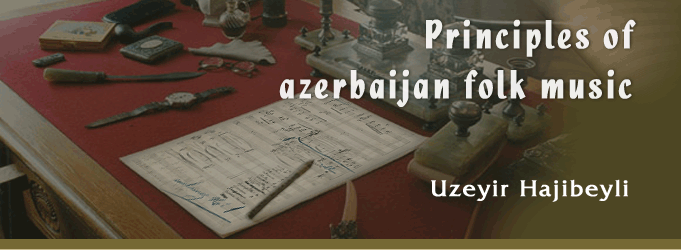

Part two
PRINCIPLES OF COMPOSING MUSIC
IN AZERBAIJANI MODES IN FOLK STYLE
I. STRUCTURE OF PERFECT QUARTES3. Composing melodies in the mode "Shur"
A. Diapason of the mode scale"Shur"
Three equal tetrachords constructed by formula 1 - 1/2 - 1 and combined conjointly (chain combination) form the scale of the mode "Shur". In this scale the first degree of the medial tetrachord is a tonic of the mode. With the tonic re of the first octave the scale of the mode "Shur" can be presented thus:
This scale consists of gradual succession of perfect quartes.
B. Modal functions of degrees and permissible leaps
In this scale the former tonic of the mode "Rast" (3-rd degree is do) retains the right of being the main tone of the scale. In the above scale:
1-st degree of the scale functions as a mediant of the main tone. It has no direct connection with the tonic of the mode "Shur", and it is included neither in the gradual movement, nor in the leaps.
2-nd degree of the scale functions as a subtonic of the main tone. In the mode "Shur" leaps from this degree are not allowed.
3-rd degree is the main tone of the scale. Leaps from this degree are permitted to the third, quarte and quinte of the main tone.
4-th degree of the scale functions as a tonic of the mode. Leaps from this degree are permitted only in the ascending direction: to the upper mediant, to the quarte and quinte.
5-th degree of the scale functions as a supertonic of the keynote and as a subtonic of the upper mediant. This degree requires lowering or softening in the following cases:
1) when it is between the tonic and its repetition;
2) when a leap is made from the main tone:
3) when after the tonic a leap is made to the main tone.
For example:
Note: Lowering of the above degree after the upper mediant does not conform the style of Azerbaijani music. Leaps from this degree (not lowered) are permitted upwards - only to the quarte of the tonic, but downwards - to the above given degree after the upper mediant does not conform unique style of Azerbaijani music.
6-th degree of the scale functions as an upper mediant of the tonic. Leaps from this degree are possible: upwards - to the quinte of the tonic, downwards - to the tonic and the main tone.
7-th degree functions as a quarte of the tonic. Leaps from this degree are permitted: upwards - to the supertonic of the tonic quinte, and also to the boundary tone of the scale, downwards - to the subtonic of the upper mediant, to the tonic, and also to the main tone.
8-th degree of the scale functions as a quinte of the tonic. Leaps are allowed: upwards - to the boundary tone, downwards - to the upper mediant of the tonic and to the tonic.
9-th degree of the scale functions as a supertonic of the quinte of the tonic. A leap is allowed only to the upper quarte of the tonic.
10-th degree of the scale functions as a boundary tone. Leaps are allowed only downwards - to the quinte and quarte of the tonic.
[Shur: pages 1 2 3 4 5 ]

